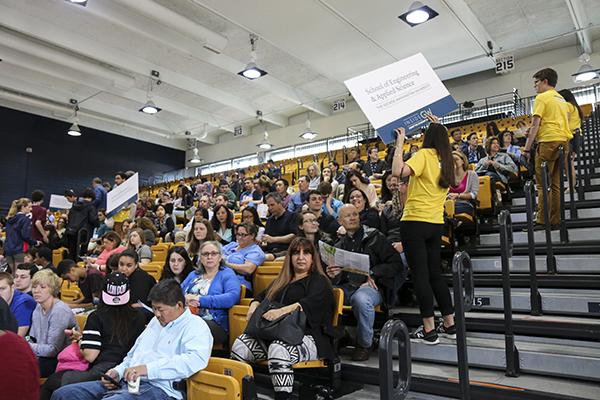Updated: April 23, 2015 at 6 p.m.
When newly admitted students walk onto campus this month, they will be greeted by cookies to eat with milk in wine glasses, brightly colored lanyards, buff-and-blue buttons and dessert tables filled with lemon squares, cake pops and lemonade.
The University revamped admitted students days this year to give students and their parents a more upscale experience, a move experts say could seal the deal for undecided students coming to campus. The number of April visit days also increased to five, and the program was rebranded as “Inside GW” — giving students and parents a glimpse into life in Foggy Bottom.
Last month, GW accepted 45 percent of applicants, the highest acceptance rate in a decade, in a move to potentially create a larger freshman class and bring in more revenue. A larger freshman class, which could grow by about 150 to 200 students, could also help alleviate the University-wide budget crunch.
Officials divided students and parents into specialized sessions for the first time, giving them more opportunities for face time with administrators and potential classmates. Sessions for parents included topics like financial aid and career services, where parents texted questions to administrators.
Meanwhile, students toured classrooms, listened to sample lectures from professors and attended a “speed mingle” event with current and other prospective students. The University also created a phone app for students and parents to look up the day’s scheduled events.
Experts say the glitzier set of admitted students days could help the University increase its yield rate, the percentage of students who commit to GW after being admitted. As students have increasingly applied to more schools nationwide, it becomes harder for officials to predict where they will end up – but getting that estimation right is key at GW as officials look to grow revenue from tuition.
Dean of Admissions Karen Felton said in an email that the University changes the programs for accepted students each year based on survey results. Planning for this spring’s programs began last summer. She said students and parents were split up this year so they could “get the most out of the day in ways that are meaningful to their individual perspective.”

Felton said the programs have always offered breakfast, lunch and snack options for prospective students and their families, but this year’s added food options are “a way to offer more variety and choices.” She declined through a spokeswoman to say how much officials spent on the admitted students days.
Colleges across the country are becoming more competitive in their efforts to draw in students, said Mark Montgomery, a college application and admissions consultant.
“You bring the kids on campus and wine them and dine them and take them on a booze cruise,” he said. “Whatever it takes to make that school look more attractive than the others. Eighteen year olds can be bought. They’re unsophisticated consumers.”
Montgomery said a high yield rate can also boost a college’s overall ranking, a statistic universities use to help attract funding for research, new buildings or other large projects.
“Every single chocolate mousse is worth it. Every kid sitting at that dessert bar is the financial health of the university,” he said.
A 2013 study by the University of Nebraska found that an in-person visit to the campus was the most influential factor for a student when picking which college to attend, more so than visiting a college’s website or meeting with a guidance counselor about potential colleges.
Anna Fabiano, who walked through the Marvin Center with her son, took the opportunity to speak with current students and ask about upcoming campus construction projects. Fabiano said she found the day’s schedule gave her a good feel for campus.
“There was never a moment where help wasn’t available,” Fabiano said.
Shadman Chowdhury, a high school senior from Long Island who was admitted into the School of Engineering and Applied Science, said his visit helped solidify his interest in GW.
“I liked the parents’ separation because it gave me more reason to see what I want to,” he said. “And I liked how they balanced it out between academics and social stuff.”
This post was updated to reflect the following correction:
In a photo caption, The Hatchet incorrectly called Karen Felton the director of admissions. Her title is dean of admissions. We regret this error.







